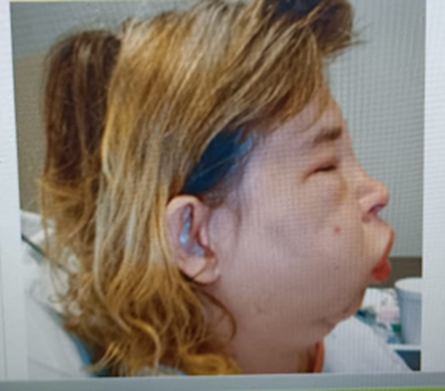A client is in the hospital and has received two doses of an angiotensin-converting enzyme (ACE) inhibitor for hypertension. When the nurse answers the client's call light, the client presents an appearance as shown below. What action by the nurse is most appropriate?

Administer epinephrine 1:1000, 0.3 mg IV push immediately.
Reassure the client that these symptoms will go away.
Ensure a patent airway while calling the Rapid Response Team.
Apply oxygen by facemask at 100% and a pulse oximeter.
The Correct Answer is C
A. Epinephrine is used in cases of severe allergic reactions or anaphylaxis, and while it may be appropriate in treating angioedema, the first priority is to ensure the airway is clear and that the client can breathe. Administering epinephrine may be part of the treatment plan but should follow securing the airway and calling for immediate advanced help.
B. This is not appropriate because angioedema can be life-threatening and can rapidly progress to airway obstruction. Reassurance without action would delay necessary interventions and could jeopardize the client’s safety.
C. In cases of angioedema, airway obstruction is the most dangerous complication, as it can lead to asphyxiation. The nurse's first priority is to ensure that the patient's airway remains open and clear. The nurse should immediately call the Rapid Response Team (RRT) for urgent medical intervention, which may include medications (like epinephrine), intubation, or other interventions. Ensuring the airway is open and calling for advanced help are the most critical first steps in managing severe cases of angioedema.
D. While oxygen therapy may be appropriate if the client shows signs of respiratory distress or hypoxia, the immediate concern is securing the airway. Oxygen may be needed after ensuring the airway is open, but the priority is to avoid airway obstruction first. The nurse should secure the airway and then administer oxygen if needed.
Nursing Test Bank
Naxlex Comprehensive Predictor Exams
Related Questions
Correct Answer is B
Explanation
A. The excitement of family does not indicate an infection risk. Emotional support can aid recovery.
B. Handling cat litter, which can contain bacteria, is a potential source of infection. Given the client's sternal wound, exposure to such bacteria increases the risk of infection, including sepsis.
C. Attending a party may present social interaction risks, but it is not as directly related to infection risk as handling cat litter.
D. Having the water turned on does not pose a significant risk for infection or sepsis.
Correct Answer is D
Explanation
A. Assuming the client is someone else's spouse based on a name may be inappropriate and could lead to misunderstanding.
B. The chart may not necessarily contain an error, and jumping to conclusions could be unprofessional.
C. Apologizing and declaring confusion may make the client uncomfortable. It's more respectful to inquire directly.
D. Asking the client about their preferred form of address is the most respectful and professional approach.
Whether you are a student looking to ace your exams or a practicing nurse seeking to enhance your expertise , our nursing education contents will empower you with the confidence and competence to make a difference in the lives of patients and become a respected leader in the healthcare field.
Visit Naxlex, invest in your future and unlock endless possibilities with our unparalleled nursing education contents today
Report Wrong Answer on the Current Question
Do you disagree with the answer? If yes, what is your expected answer? Explain.
Kindly be descriptive with the issue you are facing.
